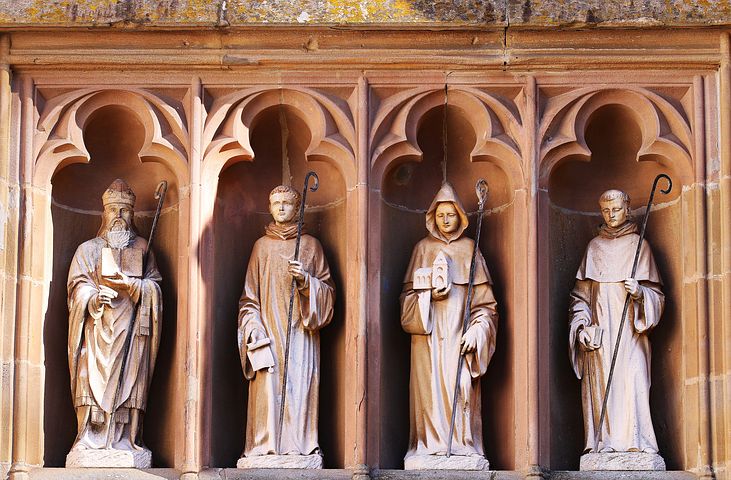The Monk in The Canterbury Tales | Character Analysis
The Monk in the General Prologue of The Canterbury Tales

The monk in the General Prologue of The Canterbury Tales is a character who, on the one hand is at odds with his religious station and on the other, questions some religious dogmas and practices through his bold and honest disobedience.
The monk seems to love the good life outside his cell. Besides riding horses and hunting hares, he loves feasting and is given to finery. He also has many dainty horses and well-bred greyhounds “as swifte as fowel “. Not a trace of the monastic life is visible in this man given to lavishness. Furthermore, there is a visible sexual element in the curious love-knotte, gold-wrought pin he wears.
According to Douglas Wurtle if there is one virtue he lacks the most, it is this: obedience. His thoughts, actions and lifestyle demonstrate the lack of utter lack of obedience. We are told that he finds the rule of Saint Maure and Saint Benedict “somdel streit”. Interestingly, the most popular legend connected tovthe two monks is a lesson on the very quality of obedience.The story goes that the absolute obedience of St Maure to Saint Benedict once helped him miraculously save a drowning man and Saint Benedict attributed the miracle to the obedience of his disciple. By alluding to this particular duo of saints in his introduction of the monk, Chaucer seems to highlight this quality of obedience which is conspicuous through its absence. The monk also rejects the teachings of the Augustinian order which focuses on the importance of penance and physical suffering. This disobedience is coupled with outright rejection of dogmas that do not sync with his lifestyle. He doesn’t believe the claim that “Hunters ben nat holy men” nor does he agree to the dictum that a monk negligent towards his vocation and out of his cell is like a fish outside water.
The concern about the loss of respect towards the clergy (as seen in John Gowler’s ‘On Monks ‘ Mirrors of Men ) seems to be well founded as the clergy is shown to be massively riddled with corruption and deceit. The General Prologue is replete with the criticism of the clergy. Barring the Parson, invariably all the members of the clergy ranging from the Summoner to the Pardoner are subject of Chaucer’s satire. Though the monk is included in this critique, the criticism directed against him seems to be of a different kind: that of being a misfit in the monastic order. He values materialistic life over a monastic one and seems to be a hedonist. However, unlike other members of the clergy, neither does he pretend to profess something that he is not, nor does he abuse his office by harming the laity. Neither is he deceitful like the Pardoner, nor malevolent like the Friar.
The monk is at least honest enough not to hide under the pretence of religiosity and bold enough to think and behave in a manner that is strongly anti-dogmatic. True, he isn’t true to his religious office but he is at least true to himself and this honesty elevates his apparent disobedience to a plane of personal rebellion. Now, whether Chaucer encourages this form of rebellion or undercuts the actions of the monk through his semi-ironic tone in which he describes the monk is a subject of another debate.
To cite this article, copy the URL below :
1. Chaucer, Geoffrey, The Canterbury Tales : Nine Tales and the General Prologue , Norton Critical Edition, Edited by V.A Kolve and Glending Olson
2. Wurtele J., Douglas. , Chaucer’s Monk : An Errant Exegete, Literature and Theology, Vol. 1, No. 2 (September 1987) Literature and Theology, Oxford University Press
3. Lenaghan, R. T. , Chaucer’s General Prologue as History and Literature
Comparative Studies in Society and History, Vol. 12, No. 1 (Jan., 1970), Cambridge University Press
4. Reiss, Edmund , The Symbolic Surface of the “Canterbury Tales”: The Monk’s Portrait. Part II, The Chaucer Review
Vol. 3, No. 1 (Summer, 1968), Penn State University Press
5. Scott-Macnab,David, “Of prikyng and of huntyng for the Hare” : General Prologue to “The Canterbury Tales”, The Journal of English and Germanic Philology, Vol. 104, No. 3 (Jul., 2005), University of Illinois Press
6. Andrew, Malcolm Context and Judgment in the “General Prologue” , The Chaucer Review, Vol. 23, No. 4 (Spring, 1989), Penn State University Press
7. Nolan, Barbara, A Poet Ther Was”: Chaucer’s Voices in the General Prologue to the Canterbury Tales, PMLA Vol. 101, No. 2 (Mar., 1986), Modern Language Association
8. Leicester, Jr, H. Marshall .The Art of Impersonation: A General Prologue to the Canterbury Tales , PMLA Vol. 95, No. 2 (Mar., 1980), Modern Language Association
9. Nevo,Ruth, Chaucer: Motive and Mask in the “General Prologue”, The Modern Language Review , Vol. 58, No. 1 (Jan., 1963), Modern Humanities Research Association

The monk seems to be a pretty misunderstood figure. This character analysis of the monk is quite interesting. Thanks for the perspective.
Yes indeed he is. You’re welcome.
Really interesting post!